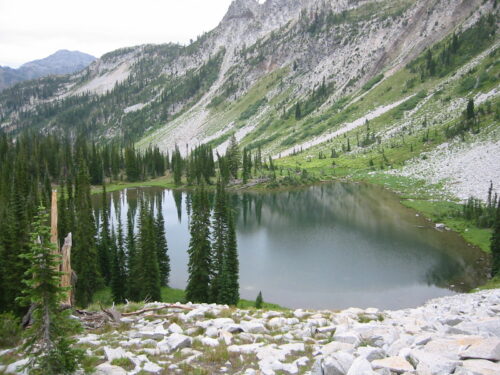
Wildlife Conservation
The North American Model of Wildlife Conservation
The North American Model of Wildlife Conservation (NAMWC) came about in response to activities such as trapping pushing many species to the brink of extinction. Today, trapping still remains contrary to the 7 focal points of the North American Model. For their own personal fun and profit, trappers continue to indiscriminately kill wildlife, most unaccounted for, and rob tax payers and the public. It is us, not even them, that pay for trappers to exploit wildlife, including protected species, for their personal gain.
“Conflicts with the NAMWC prohibition against the frivolous killing and waste of wildlife. Given that few hunters actually consume coyotes, wolves, cougars, and except for a few individuals, even bears, it is obviously a “waste” of wildlife to shoot or trap these animals just for “fun”.
Contrary to Trapping…
Principles of Wildlife Conservation for the 21st Century:
- Wildlife has aesthetic, cultural, ecological, economic, intrinsic, recreational, scientific, social, and spiritual values that need to be acknowledged, preserved and passed on to future generations.
- Recognizing that wildlife has intrinsic value broadens conservation to include both individual animals and the populations they comprise. In other words, 21st century “geocentric” conservation must be concerned about the welfare of individual animals (traditionally termed animal welfare, or animal protection) and the welfare of wild populations (the traditional focus of progressive conservation).
- As a consequence, “people should treat all creatures decently, and protect them from cruelty, avoidable suffering, and unnecessary killing.” This principle reaffirms that animal welfare is an integral part of modern conservation.
- Conservation measures that compromise the welfare of individual animals to achieve goals at the level of the population should not be the preferred means of addressing wildlife conservation issues.
- Capturing wild animals for live trade and captivity should not be permitted. Bringing individual wild animals into captivity for short periods may be permitted, however, to deal with animal welfare issues such as disease, injury or estrangement.
- All attempts to domesticate wild animals should be discouraged.
- Efforts to protect and conserve wildlife and wildlife habitat should begin long before species become rare and more costly to protect.
- The maintenance of viable wildlife populations and functioning ecosystems should take precedence over their use by people.
- Recreational and other uses of wilderness must not compromise the very essence of “wilderness” as untrammeled wild lands, and any such uses should be compatible with this basic principle.
- Wildlife belongs to everyone and no one. It is protected and held in trust for society by governments or appropriate intergovernmental conventions (i.e. central management authorities at an appropriate scale).
- “Highly migratory species” belong to all nations and not just those that wish to exploit them.
- Effective conservation of wildlife relies upon a well-informed and involved public.
- Any material benefits derived from wildlife must be allocated by law – following consultation with the public, who collectively “own” the resource – and not by the marketplace, birthright, land ownership, or social position.
- All individuals share the costs of conserving wildlife. Those whose actions result in additional costs should bear them.
- The onus must be on those who wish to use nature and natural resources, e.g. exploiters and developers, to demonstrate that their actions will not be detrimental to the goal of achieving biological and ecological sustainability.
- The exploiter/developer pays. Those exploiting wildlife should bear the full costs of ensuring that any exploitation is ecologically sustainable, including the cost of enforcing any catch limits, and any scientific research
- required to determine those catch limits. Exploitation (and depletion) of wild living resources should no longer be subsidized by governments.
- The use of wildlife for subsistence purposes by human populations should not be equated with their commercial consumptive use.
- Use of wildlife and ecosystems should be frugal (parsimonious) and efficient (not wasteful), ensuring that any use is biologically and ecologically sustainable. (Parsimonious use means taking as little as you need, rather than as much as deemed possible as implied, for example, by the idea of maximum sustainable yield.)
- Human development should not threaten the integrity of nature or the survival of other species.
- Development of one society or generation should not limit the opportunities of other societies or generations.
- Each generation should leave to the future a world that is at least as biologically and ecologically diverse and productive as the one it inherited, and – given the current state of the planet – a world in which the physical environment (including the land, water, and atmosphere) is less polluted than the one it inherited.
- The establishment of protected areas – where human impacts, including exploitation and development, on wildlife and their habitats are reduced to an absolute minimum – is an essential component of any plan to achieve biological and ecological sustainability.
- Ultimately, human use of nature must be guided by humility, prudence, and precaution.
By Dr. David M. Lavigne, “Gaining Ground: In Pursuit of Ecological Sustainability”.
The North American Model of Wildlife Conservation
by Dr. Tom Serfass
Some points:
Public land is ultimately purchased and paid for by the tax payer.
Key words: Polarization, Marketing, Social Science, Influences, Discord resulting in them vs us.
Agency influence and the need to promote wildlife with honest education.
43% of almost 19 million Americans participating in shooting sports, thereby contributing to the 11% excise tax for Pittman Robertson Funds, reported they did not hunt.
Reintroductions of river otter involved trapping but trappers fail to mention the type. 4,000 reintroduced with 2000 of them in cage traps.
70% of the River Otters caught in leghold traps sustained injuries requiring amputation.
Dr. Tom Serfass: Chair and Professor of Wildlife Ecology in the Department of Biology and Natural Resources at Frostburg State University, and Adjunct Professor.
Dr. Serfass is also a hunter.